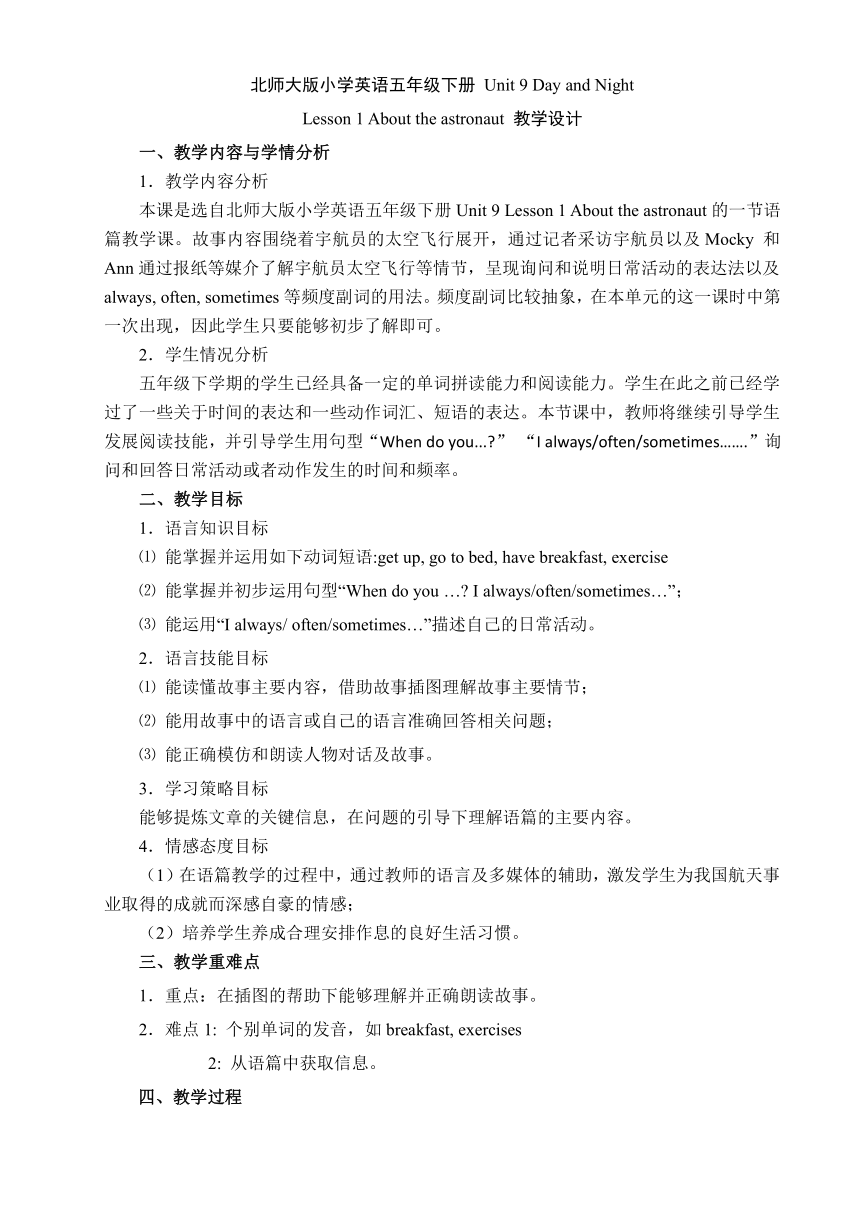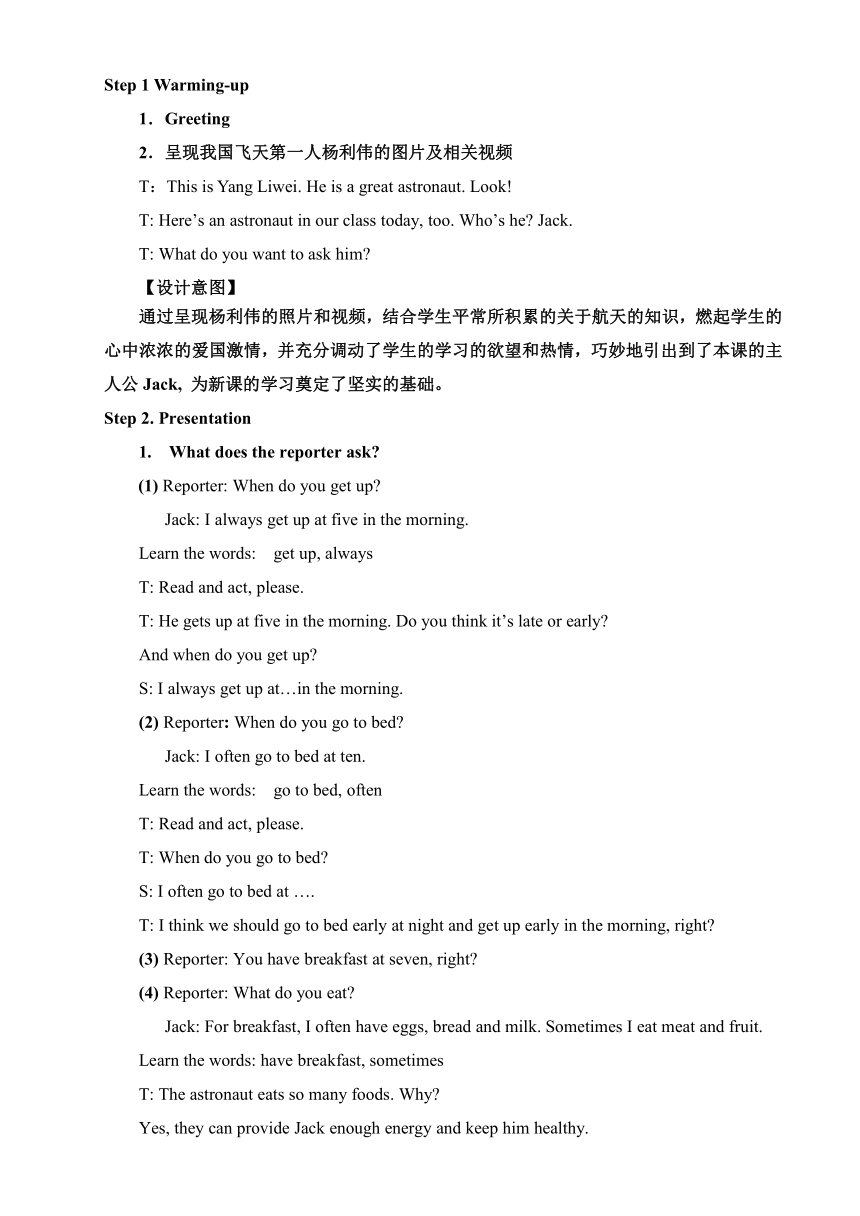Unit9 Day and night Lesson1 教案
文档属性
| 名称 | Unit9 Day and night Lesson1 教案 |  | |
| 格式 | doc | ||
| 文件大小 | 337.5KB | ||
| 资源类型 | 教案 | ||
| 版本资源 | 北师大版(三年级起点) | ||
| 科目 | 英语 | ||
| 更新时间 | 2021-06-22 10:34:17 | ||
图片预览


文档简介
北师大版小学英语五年级下册 Unit 9 Day and Night
Lesson 1 About the astronaut 教学设计
一、教学内容与学情分析
1.教学内容分析
本课是选自北师大版小学英语五年级下册Unit 9 Lesson 1 About the astronaut的一节语篇教学课。故事内容围绕着宇航员的太空飞行展开,通过记者采访宇航员以及Mocky 和Ann通过报纸等媒介了解宇航员太空飞行等情节,呈现询问和说明日常活动的表达法以及always, often, sometimes等频度副词的用法。频度副词比较抽象,在本单元的这一课时中第一次出现,因此学生只要能够初步了解即可。
2.学生情况分析
五年级下学期的学生已经具备一定的单词拼读能力和阅读能力。学生在此之前已经学过了一些关于时间的表达和一些动作词汇、短语的表达。本节课中,教师将继续引导学生发展阅读技能,并引导学生用句型“When do you...?” “I always/often/sometimes…….”询问和回答日常活动或者动作发生的时间和频率。
二、教学目标
1.语言知识目标
⑴ 能掌握并运用如下动词短语:get up, go to bed, have breakfast, exercise
⑵ 能掌握并初步运用句型“When do you …? I always/often/sometimes…”;
⑶ 能运用“I always/ often/sometimes…”描述自己的日常活动。
2.语言技能目标
⑴ 能读懂故事主要内容,借助故事插图理解故事主要情节;
⑵ 能用故事中的语言或自己的语言准确回答相关问题;
⑶ 能正确模仿和朗读人物对话及故事。
3.学习策略目标
能够提炼文章的关键信息,在问题的引导下理解语篇的主要内容。
4.情感态度目标
(1)在语篇教学的过程中,通过教师的语言及多媒体的辅助,激发学生为我国航天事业取得的成就而深感自豪的情感;
(2)培养学生养成合理安排作息的良好生活习惯。
三、教学重难点
1.重点:在插图的帮助下能够理解并正确朗读故事。
2.难点1: 个别单词的发音,如breakfast, exercises
2: 从语篇中获取信息。
四、教学过程
Step 1 Warming-up
1.Greeting
2.呈现我国飞天第一人杨利伟的图片及相关视频
T:This is Yang Liwei. He is a great astronaut. Look!
T: Here’s an astronaut in our class today, too. Who’s he? Jack.
T: What do you want to ask him?
【设计意图】
通过呈现杨利伟的照片和视频,结合学生平常所积累的关于航天的知识,燃起学生的心中浓浓的爱国激情,并充分调动了学生的学习的欲望和热情,巧妙地引出到了本课的主人公Jack, 为新课的学习奠定了坚实的基础。
Step 2. Presentation
1. What does the reporter ask?
(1) Reporter: When do you get up?
Jack: I always get up at five in the morning.
Learn the words: get up, always
T: Read and act, please.
T: He gets up at five in the morning. Do you think it抯 late or early?
And when do you get up?
S: I always get up at卛n the morning.
(2) Reporter: When do you go to bed?
Jack: I often go to bed at ten.
Learn the words: go to bed, often
T: Read and act, please.
T: When do you go to bed?
S: I often go to bed at .
T: I think we should go to bed early at night and get up early in the morning, right?
(3) Reporter: You have breakfast at seven, right?
(4) Reporter: What do you eat?
Jack: For breakfast, I often have eggs, bread and milk. Sometimes I eat meat and fruit.
Learn the words: have breakfast, sometimes
T: The astronaut eats so many foods. Why?
Yes, they can provide Jack enough energy and keep him healthy.
【设计意图】单词、短语以及句型的学习都离不开具体的语境,在这一环节中, 让学生带着问题看课文动画、以学生的视角出发,发现文中记者提出的问题,让学生模拟记者与宇航员之间的问答,使学生充分融入在课文情境中,在此基础上学习本课主要的语言知识点,然后通过师生之间真实的交流对话:When do you…? I always/often/sometimes…at… 让学生体会到了语言交流的真实性。Why?这一问题的提出有助于鼓励学生积极思考,拓展他们的思维,使对话更趋于真实和自然。
(5) Listen and repeat.
(6) Retell this part of the story
T: Now, I’m the reporter. You’re Jack.
T: When do you get up/ go to bed/ have breakfast?
Ss answer the questions.
One student to be the reporter to ask questions, the others answer.
【设计意图】复述是语言输出的重要形式,可以培养学生的语言记忆能力和表达能力。这一环节的复述活动中,通过师生分别扮演记者和宇航员对话的方式,再现课文中记者与宇航员的问答,梳理课文第一部分的内容,进一步突破教学难点,降低复述难度,同时让学生内化所学语言。
2. What does he do every day?
(1) T: These are the daily activities about an astronaut, and what else does he do?
Read the pictures from 6 to 9, find out the answers and underline.
Ss read the pictures, and looking for the answers.
T: What does he do every day?
S: He has many things to do.
T: What things are mentioned here? Please choose the pictures.
Learn the words and phrases: read books, exercise, take a walk in space
Read and act.
【设计意图】提出本部分的关键问题“What does he do every day?”,引导学生深入阅读文本,找出核心信息,培养学生的阅读能力。再以表演的方式呈现、巩固关键词汇,增加课堂的趣味性,保持了学生学习的积极性和热情。
(2) How often does he do these things?
He reads books. (sometimes) He exercises. (always)
He takes a walk in space. (sometimes)
【设计意图】回归文本,通过引导学生再次仔细阅读,从而再次提炼出本课的关键信息----频度副词这一知识点,在强化语言知识点的同时,教给学生关于语篇阅读的技巧。
(3)Listen and repeat.
(4) Retell this part of the story.
【设计意图】
Presentation环节围绕本课的两个大板块展开:1、记者与宇航员之间的对话。 2、报纸中关于宇航员日常活动的描述。通过情境对话、自主阅读等方式理清文章脉络,关注语篇细节。在此过程中,根据学生的具体情况,提出合理、有效的问题供学生思考,充分挖掘学生已有的语言知识,并引导学生联系生活实际,鼓励他们大胆表达,并适时培养学生的语篇阅读能力。
Step 3. Practice
1. Read the story in groups.
2. Choose and read.
【设计意图】以小组合作阅读的方式让学生重新回归文本,给学生更多的机会开口朗读,展示环节也以小组为单位,这样的合作学习能够让一些水平稍弱的学生克服恐惧心理,有助于他们建立起学习英语的信心。
Step 4. Production
1.My daily activities
T: These are daily activities about the astronaut, and here’s a video about me.
Ss watch the video together.
2.What about you?
T: OK, please take out this piece of paper, write some sentences about you daily activities.
3. Show time.
4. 情感升华,教育。
T: Good habits, good life.
【设计意图】从语篇中提炼出来的词汇、短语这些知识,目的是让学生能用上这些语言知识表达自己的日常活动,在本环节中,通过让学生写出自己的日常活动,并且口头表达出来,实现了这一目的。
Step 5. Homework
1.Read the story to your family.(☆☆);
2.Talk about your daily activities with your friends. (☆☆☆)
【设计意图】第一项作业要求学生多听多模仿,形成良好的语音语调;第二项作业则对学生提出了更高的要求,引导学生积极主动开展语言实践活动,从而提高学生的语用能力。
板书设计:
Lesson 1 About the astronaut 教学设计
一、教学内容与学情分析
1.教学内容分析
本课是选自北师大版小学英语五年级下册Unit 9 Lesson 1 About the astronaut的一节语篇教学课。故事内容围绕着宇航员的太空飞行展开,通过记者采访宇航员以及Mocky 和Ann通过报纸等媒介了解宇航员太空飞行等情节,呈现询问和说明日常活动的表达法以及always, often, sometimes等频度副词的用法。频度副词比较抽象,在本单元的这一课时中第一次出现,因此学生只要能够初步了解即可。
2.学生情况分析
五年级下学期的学生已经具备一定的单词拼读能力和阅读能力。学生在此之前已经学过了一些关于时间的表达和一些动作词汇、短语的表达。本节课中,教师将继续引导学生发展阅读技能,并引导学生用句型“When do you...?” “I always/often/sometimes…….”询问和回答日常活动或者动作发生的时间和频率。
二、教学目标
1.语言知识目标
⑴ 能掌握并运用如下动词短语:get up, go to bed, have breakfast, exercise
⑵ 能掌握并初步运用句型“When do you …? I always/often/sometimes…”;
⑶ 能运用“I always/ often/sometimes…”描述自己的日常活动。
2.语言技能目标
⑴ 能读懂故事主要内容,借助故事插图理解故事主要情节;
⑵ 能用故事中的语言或自己的语言准确回答相关问题;
⑶ 能正确模仿和朗读人物对话及故事。
3.学习策略目标
能够提炼文章的关键信息,在问题的引导下理解语篇的主要内容。
4.情感态度目标
(1)在语篇教学的过程中,通过教师的语言及多媒体的辅助,激发学生为我国航天事业取得的成就而深感自豪的情感;
(2)培养学生养成合理安排作息的良好生活习惯。
三、教学重难点
1.重点:在插图的帮助下能够理解并正确朗读故事。
2.难点1: 个别单词的发音,如breakfast, exercises
2: 从语篇中获取信息。
四、教学过程
Step 1 Warming-up
1.Greeting
2.呈现我国飞天第一人杨利伟的图片及相关视频
T:This is Yang Liwei. He is a great astronaut. Look!
T: Here’s an astronaut in our class today, too. Who’s he? Jack.
T: What do you want to ask him?
【设计意图】
通过呈现杨利伟的照片和视频,结合学生平常所积累的关于航天的知识,燃起学生的心中浓浓的爱国激情,并充分调动了学生的学习的欲望和热情,巧妙地引出到了本课的主人公Jack, 为新课的学习奠定了坚实的基础。
Step 2. Presentation
1. What does the reporter ask?
(1) Reporter: When do you get up?
Jack: I always get up at five in the morning.
Learn the words: get up, always
T: Read and act, please.
T: He gets up at five in the morning. Do you think it抯 late or early?
And when do you get up?
S: I always get up at卛n the morning.
(2) Reporter: When do you go to bed?
Jack: I often go to bed at ten.
Learn the words: go to bed, often
T: Read and act, please.
T: When do you go to bed?
S: I often go to bed at .
T: I think we should go to bed early at night and get up early in the morning, right?
(3) Reporter: You have breakfast at seven, right?
(4) Reporter: What do you eat?
Jack: For breakfast, I often have eggs, bread and milk. Sometimes I eat meat and fruit.
Learn the words: have breakfast, sometimes
T: The astronaut eats so many foods. Why?
Yes, they can provide Jack enough energy and keep him healthy.
【设计意图】单词、短语以及句型的学习都离不开具体的语境,在这一环节中, 让学生带着问题看课文动画、以学生的视角出发,发现文中记者提出的问题,让学生模拟记者与宇航员之间的问答,使学生充分融入在课文情境中,在此基础上学习本课主要的语言知识点,然后通过师生之间真实的交流对话:When do you…? I always/often/sometimes…at… 让学生体会到了语言交流的真实性。Why?这一问题的提出有助于鼓励学生积极思考,拓展他们的思维,使对话更趋于真实和自然。
(5) Listen and repeat.
(6) Retell this part of the story
T: Now, I’m the reporter. You’re Jack.
T: When do you get up/ go to bed/ have breakfast?
Ss answer the questions.
One student to be the reporter to ask questions, the others answer.
【设计意图】复述是语言输出的重要形式,可以培养学生的语言记忆能力和表达能力。这一环节的复述活动中,通过师生分别扮演记者和宇航员对话的方式,再现课文中记者与宇航员的问答,梳理课文第一部分的内容,进一步突破教学难点,降低复述难度,同时让学生内化所学语言。
2. What does he do every day?
(1) T: These are the daily activities about an astronaut, and what else does he do?
Read the pictures from 6 to 9, find out the answers and underline.
Ss read the pictures, and looking for the answers.
T: What does he do every day?
S: He has many things to do.
T: What things are mentioned here? Please choose the pictures.
Learn the words and phrases: read books, exercise, take a walk in space
Read and act.
【设计意图】提出本部分的关键问题“What does he do every day?”,引导学生深入阅读文本,找出核心信息,培养学生的阅读能力。再以表演的方式呈现、巩固关键词汇,增加课堂的趣味性,保持了学生学习的积极性和热情。
(2) How often does he do these things?
He reads books. (sometimes) He exercises. (always)
He takes a walk in space. (sometimes)
【设计意图】回归文本,通过引导学生再次仔细阅读,从而再次提炼出本课的关键信息----频度副词这一知识点,在强化语言知识点的同时,教给学生关于语篇阅读的技巧。
(3)Listen and repeat.
(4) Retell this part of the story.
【设计意图】
Presentation环节围绕本课的两个大板块展开:1、记者与宇航员之间的对话。 2、报纸中关于宇航员日常活动的描述。通过情境对话、自主阅读等方式理清文章脉络,关注语篇细节。在此过程中,根据学生的具体情况,提出合理、有效的问题供学生思考,充分挖掘学生已有的语言知识,并引导学生联系生活实际,鼓励他们大胆表达,并适时培养学生的语篇阅读能力。
Step 3. Practice
1. Read the story in groups.
2. Choose and read.
【设计意图】以小组合作阅读的方式让学生重新回归文本,给学生更多的机会开口朗读,展示环节也以小组为单位,这样的合作学习能够让一些水平稍弱的学生克服恐惧心理,有助于他们建立起学习英语的信心。
Step 4. Production
1.My daily activities
T: These are daily activities about the astronaut, and here’s a video about me.
Ss watch the video together.
2.What about you?
T: OK, please take out this piece of paper, write some sentences about you daily activities.
3. Show time.
4. 情感升华,教育。
T: Good habits, good life.
【设计意图】从语篇中提炼出来的词汇、短语这些知识,目的是让学生能用上这些语言知识表达自己的日常活动,在本环节中,通过让学生写出自己的日常活动,并且口头表达出来,实现了这一目的。
Step 5. Homework
1.Read the story to your family.(☆☆);
2.Talk about your daily activities with your friends. (☆☆☆)
【设计意图】第一项作业要求学生多听多模仿,形成良好的语音语调;第二项作业则对学生提出了更高的要求,引导学生积极主动开展语言实践活动,从而提高学生的语用能力。
板书设计:
